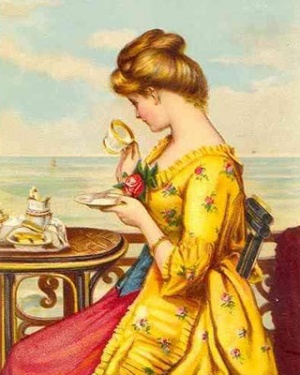Viewing the Cup
From Mystic Tea Room
(edit and save) |
(→Gazing With Your Eyes Only) |
||
| Line 16: | Line 16: | ||
==Gazing With Your Eyes Only== | ==Gazing With Your Eyes Only== | ||
| - | [[File:Victorian-trade-card-tea-leaf-reader.jpg|right|thumb|300px| Gazing into the cup with your eyes only; a [http://yourwateandfate.com/Categorizing_Cards Victorian era trade card] for a [[Tea|tea dealer ]]shows a woman reading her cup.]] | + | [[File:Victorian-trade-card-tea-leaf-reader.jpg|right|thumb|300px| Gazing into the cup with your eyes only; a [http://yourwateandfate.com/Categorizing_Cards Victorian era trade card] for a [[Tea|tea dealer]] shows a woman reading her cup.]] |
When reading a teacup for yourself it is the simplest and most natural thing in the world to simply look into the cup and see pictures among the leaves. | When reading a teacup for yourself it is the simplest and most natural thing in the world to simply look into the cup and see pictures among the leaves. | ||
Revision as of 04:03, 15 August 2022
Although it seems a simple thing to look into the tea cup and see images in the leaves, there are at least three ways to do so. The results may be the same, but the manner of presentation is different. All are traditional and none is "better" than another.
Let us begin with the usual drinking off of the tea, the swirling or swinging of the cup, the inversion and rotation of the cup in the saucer, and the tapping of the bottom. Not every reader does all of these things, but most readers understand the method and follow its general principles. For more complete details, see "The Stranger in the Cup" by Gregory White and Catherine Yronwode.
Next comes the handling of the cup as you look within for the images:
- If you are reading for yourself, hold the cup in your dominant hand and tip it slightly toward you, as if about to take a drink, then consider what images appear.
- If you are reading for a sitter, start by holding the cup the way the sitter did (right handed or left handed) and tipping it toward you as he or she did when taking the last sip from the cup. If you see nothing, rotate the cup slightly, a few degrees at a time, until an image comes into view. Remember, even "non-images" like a row of dots do have a meaning.
- Do not set the cup down until you finish your reading, for if you do, the residual liquid in the cup may cause the images to slide, change, and become disfigured.
All right, having understood what your hands will do during the reading, now we can look at the three major variations in how the reading is performed.
Gazing With Your Eyes Only

When reading a teacup for yourself it is the simplest and most natural thing in the world to simply look into the cup and see pictures among the leaves.
You do not need to touch the leaves or explain to yourself or anyone else what they look like, because your eyes convey the information directly to your brain.
This method, which i call "Gazing" is meditative and quiet. If you want to memorialize such a reading, all you have to do is photograph it at the angle which best displays the images that you see. If you are an artist, you might prefer to draw it. Date your reading so you can refer to it again and annotate the image if it "comes true.
In a way, gazing is so trivial that it seems odd to mention it as a "method." However, when we move on to the next methods, you will understand that it is, in fact, one of several ways to view a cup.
Sharing the Gaze With a Family Member, Friend or Client
If you are reading for a sitter who is emotionally close to you, such as a family member, or if you are showing your own cup to a friend who will in turn be showing hers to you, it is common practice to hold the cup up, sit very close to one another, or have your friend look over your shoulder and ask them if they see the image.
Asking for the gaze of another person can take the form of a game -- "Do you see the squirrel?" or "I see a squirrel -- what do YOU see?" However, if you pose a question in these ways, you must be prepared for your friend or family member to disagree with you -- to see something else, or to see nothing at all, and perhaps to only grudgingly see what you behold so vividly.
When reading tea cups professionally, you should never get into a game of "Do you see what i see?" with the sitter. YOU, after all, are the reader; the sitter has come to you for answers, not for a play-party. Tell the client what you see and interpret it.
Indicating the Image with a Finger
Taking control of the reading can be as simply as pointing out the images with a finger. Now your family member or friend will have to see what you see. "I see a squirrel on a branch. Se? Here is his tail, all arched up ... and he is holding a nut between his little hands." Your verbal description, and the use of a guiding finger, makes the image clear.
However, to use this method, you must still sip




